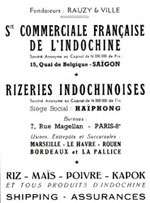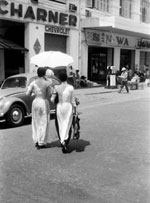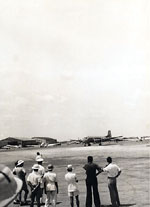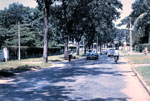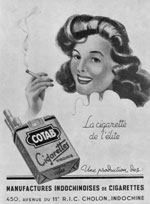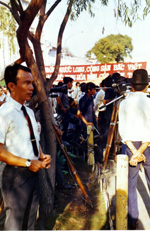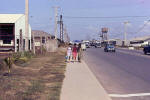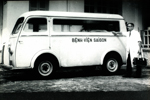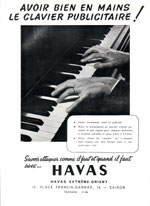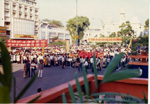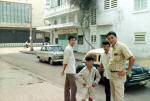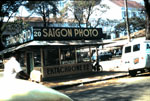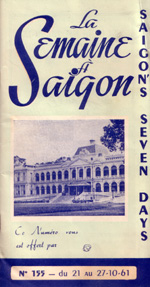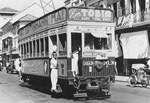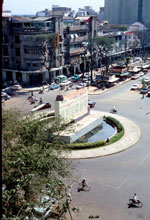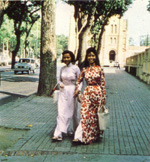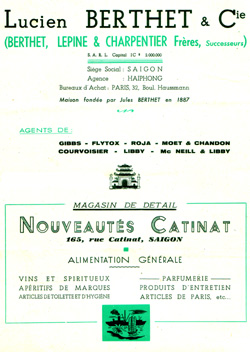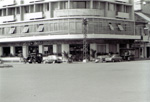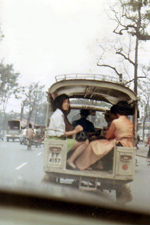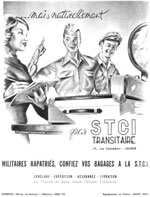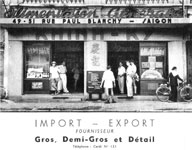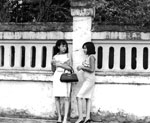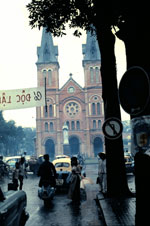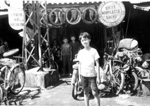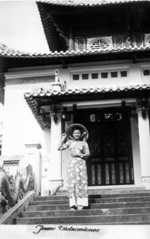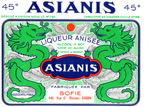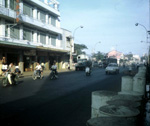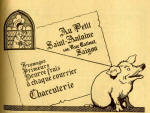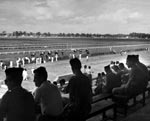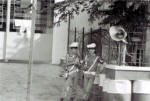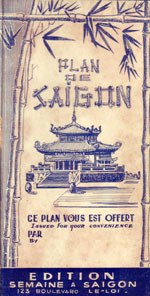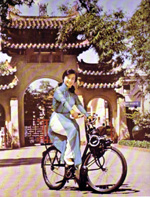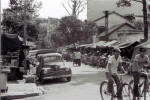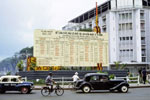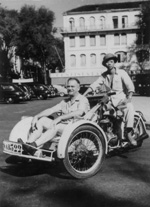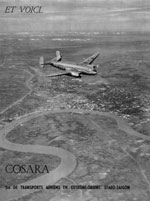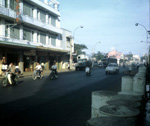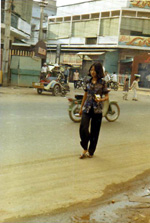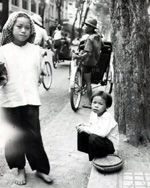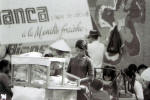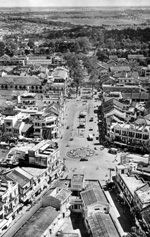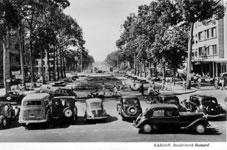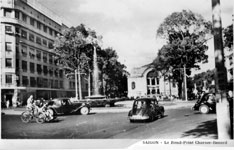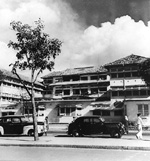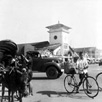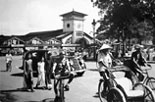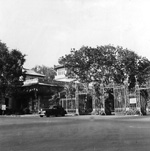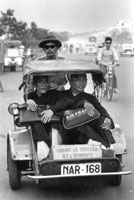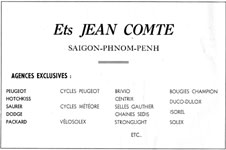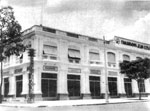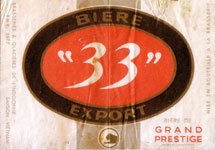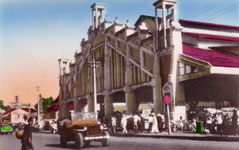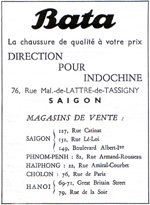
Bonard Boulevard (now L├¬ Lợi )
Named after the first Governor-Admiral of Cochin-China, appointed by Emperor Napoleon III from November 30th ,1861 to October 16th, 1863.

- at 20 Bonard Boulevard
Nam Anh Limited
Radio & Electricity shop
SCAMA
- 28-39 Bonard Boulevard
SCAMA Garage "Ford Vedette"
Le Rond-Point Charner Bonard
Corner of the Bonard Boulevard and Charner Boulevard
Kim Long Restaurant
and Nightclub Bong Lai
The excellent chinese restaurant "Kim Long" was located on Bonard (Lê Loi) Boulevard.
ARVN War memorial
The ARVN Marines statue was situated right in front of the National Assemby or today's Municipal Theater.
It was toppled after 1975 and replaced by the statue of mother and child.
Grand Pharmacy of Saigon Nguyen-Van-Cao
- 120-124 Bonard Boulevard
Bonard theater
- 121, Bonard boulevard
Polyclinic Dejean de la Bâtie
- 125 Bonard Boulevard
The Casino de Saigon (now Kem Bach Dang)
- the "Casino de Saïgon" is located at the corner of Bonard Boulevard (Le Loi ) and Pellerin Street (Pasteur).
The Central Market (now Ben Thanh)
The Central market is located at the corner of Boulevard de la Somme and Boulevard Bonnard, to the right of the station on Eug├Ęne Cuniac Square. It was built in 1914 by a French company based in Saigon, at 48, Richaud Street; the ÔÇťBrossard and MopinÔÇŁ Company. This building is still the used as a market, it has four main doors, (east, west, north, and south), and the latter with its clock tower has become the current symbol of Ho Chi Minh City.
The ÔÇťBrossard and MopinÔÇŁ Company carried out many construction projects in Indochina such as the Hon Gay coal mines railroad, infrastructures on the Vi├ętry railroad at Lao Kay, on the Yunnan railroad; the station at Hanoi; 6000 meters (3.7 miles) of wharves in Saigon harbor; headquarters buildings such as that of the Bank of Indochina; the first 4- and 5-story apartment buildings on Catinat Street, as well as large-scale projects in China and Singapore
Market Square
On the left the bus station, at the center the dance hall "Le Tabarin" located in Bourdais Street, on the right the railway station.
On the right the Market Square (Ben Thanh).

Norodom Boulevard
(now L├¬ Duẩn)
On August 1st, 1863, King Norodom of Cambodia asked for France's help to avoid takeover by Siam (now Thailand) and Annam (now Vietnam).
By the protectorate treaty, King Norodom the 1st prohibits any relationship with a foreign power without France's approval, and a general resident is established in Pnom Penh. In 1887 Cambodia became part of French Indochina.
Norodom Palace (Gouvernor's Palace)
The original Palace was built between 1868 and 1873 by the French, following plans by the architect Hermitte, and in a neo-baroque style that was very Napoleon III. Under the Second Empire and the Third Republic, it was first used as the Governor's residence (Norodom Palace), then as that of the Governor-General of French Indochina.
Independance Palace
In 1954 France turned the palace over to Ngo Dinh Diem and it became the seat of government as well as the Presidential Palace of the Republic of South Vietnam. The palace was severely damaged in 1962. Ngo Dinh Diem ordered it to be torn down and commissioned its reconstruction by Vietnamese architect Ng├ Vi├¬t Thu. Ngo Dinh Diem was assassinated in November of 1963 by a military coup, and the new Palace of Independence would be completed in 1966 and would remain the seat of the South Vietnamese government until April 30th, 1975, and was where the tanks broke down the gates. It is now called the Palace of Reunification.
The Zoo
This boulevard starts in front of the Norodom Palace and passes behind Notre-Dame cathedral to open onto the Botanical and Zoological gardens, founded in 1865 by French botanist Jean-Baptiste Louis Pierre with over a thousand species of plants.
The Botanical Garden
The Avalanche Bridge
Blanchard de la Brosse museum
"Vien Bao Tang Lich Su"
now Vietnam History Museum
The museum is located in the Botanical and Zoological gardens.
It was built by Auguste Delaval and it was inaugurated on 1st January 1929.
It traces the Vietnam's history from antiquities until 1930.
Foyer du Soldat et du Marin
- at number 4 le " Foyer du Soldat et du Marin " avec sa piscine et ├á c├┤t├ę de la Maison de la Radio.
Air France Agency
- " 12 " Air France Agency "
Claude Bourrin Theater
- " 23 Claude Bourrin Theater

The Jean Comte Company since 1920
Headquarters:
34 Norodom Boulevard
Saigon
Tel: 20.257 et 22.527
Concessionaire for::
Automobiles and parts: Peugeot, Hotchkiss, Dodge, Packard, Saurer
Peugeot 202 and 203 automobiles at the Jean Comte Garage
Cycles and motorcycles: Peugeot, Meteore, as well as, from 1950 on, the famous V├ęlosolex.
V├ęlosolex and Peugeot motorcycle at the Jean Comte Garage
Tires: Michelin
Miscellaneous: Sedis chains, Champion, Jaeger, Marchal, Solex, Shell, Isorel
Branch office
11 Doudars de La Gr├ęe Boulevard
Phnom-Penh
Paris office: 17, rue Daru
Paris VIII
General administrator: M. Marcel Laurent
Board members:
Mr. J.B. Comte (president)
Mr. J.R. Comte (vice-president)
A corporation with a capital of 127,500,500.- francs.
The V├ęlosolex in Vietnam
The VeloSoleX first appeared in Indochina in 1950 when the Jean Comte Establishments imported the first velosolex 45s into the 3 countries on the peninsula: Laos, Cambodia and South Vietnam.
The VeloSoleX was very popular in the cities of South Vietnam, especially Saigon, Hue, and Tourane, its story ended in 1975.

Paul Blanchy Street
(Haï Ba Trung)
Paul Blanchy (1837-1901), son of a merchant from Bordeaux, moved to Indochina in 1871 and developed pepper farming.
He was elected the first mayor of Saigon, from 1895 to 1901, having been president of of the Colonial Council of Cochin-China in 1873. Saigon was the only city in colonial Vietnam to have an elected mayor.
Breweries and Ice-Houses of Indochina "BGI"
At 6, Paul Blanchy Street
Saigon
Tel : 20.311 et Ca : 528
Products manufactured: Ice, Beer, Soft Drinks.
Branches : Saigon - Cholon - Phnom Penh - Hanoi - Haiphong.
Manager: Mr. H. Murtin
B.G.I. will cease its activities in Indochina in 1976 to settle in North Africa and Southern Africa.
The « Brasseries et Glaci├Ęres d'Indochine » (Breweries and Ice-Houses
of Indochina) which made the famous “Larue” and “33” export beers.
At the end of the 19th century, a demobilized top sergeant of the French Army took up beer-making in Saigon by joining a brewer from Hanoi, a certain Hommel, to found the Breweries and Ice-Houses of Indochina, (BGI).
After the death of its founder, The Denis Brothers, the company of the four brothers from Bordeaux which had been in Saigon since 1862, took over the business. Over 4000 persons worked for BGI until 1975.
Larue and "33" Export Biers
Le Corsica
20, Paul Blanchy Street
Bar and Buffet
Managers Mr.& Mrs Bariani
Les Caves du Sahel
(The wine cellars from Sahel)
S. Crisias & F. Pettinato
Wines - Grocery Store
26 - 28 Paul Blanchy Street
Khinh - Ky
Grocery Store
49 - 51 Paul Blanchy Street
Tân Dinh Market
The market was built in 1926-1927 by Soci├ęt├ę d' ├ëtudes et de Constructions (SIDEC).
Rickshaw in Paul Blanchy Street

Marne Embankment
Indochina manufacturer of Juan Bastos Cigarettes and Tobacco
Indochina manufacturer of Juan Bastos cigarettes and tobacco, supplier to the French, Spanish, Tunisian, and Moroccan administration
151, Marne Embankment
Saïgon
Juan Bastos cigarettes
Douaumont Street
Indochina Tobacco & Cigarette Manufacturer M├ęlia Saigon "MITAC"
Limited Liabilty Company with a capital of 7.500.000 Piastres
121-139 Douaumont Street
Saigon
Manufactured Rubber Company
140, Douaumont Street
Saigon
Marechal de Latttre de Tassigny Street
Bata Shoes
A French corporation
Indochina Division
Shoe factories in :
Saïgon-Cholon, Hanoï-Haïphong
Headquarters :
76, Marechal de Latttre de Tassigny Street
Saigon
Somme Boulevard
Pachod Brothers
This company imported Englebert tires, Simmons mattresses, Mercier bicycles, Simplex derailleurs, Exshaw cognac, fabrics and bazaar articles into Indochina.
22, Somme Boulevard
Saigon
&
40, Henri d'Orleans Boulevard
Hanoi



